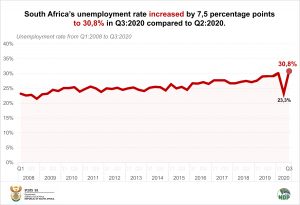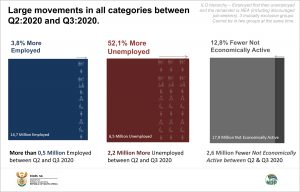Significant movements into the labour force in the 3rd quarter of 2020
In the 3rd quarter of 2020 there were significant movements in the South African labour market. According to the Quarterly Labour Force Survey (QLFS), a large number of persons moved from the “other not economically active” category to “employed” and “unemployed” status between quarter two and quarter three of 2020. The movement was proportionately more towards the unemployed than for the employed, which resulted in a significant increase of 7,5 percentage points in the unemployment rate to 30,8%. This is the highest unemployment rate recorded since the start of the QLFS in 2008.
The results indicate that the number of employed persons increased by 543 000 to 14,7 million in the 3rd quarter of 2020, and the number of unemployed persons increased by 2,2 million to 6,5 million compared to the 2nd quarter of 2020. This resulted in an increase of 2,8 million in the number of people in the labour force.
In spite of the increase in the number of discouraged work-seekers (up by 9,1%), the number of people who were not economically active for reasons other than discouragement decreased by 2,9 million between the two quarters, resulting in a net decrease of 2,6 million in the not economically active population.
To capture changes brought about by the national lockdown, the additional questions that were included in the quarter 2: 2020 questionnaire were also included in Q3: 2020. These questions have to do with the place of work; whether those in employment continued to receive salaries during lockdown; whether they received full or reduced salary; whether they would be returning to the same job/business after the lockdown; and whether they thought they might lose their jobs or their businesses would close in a foreseeable future due to COVID-19.
Of the 14,7 million persons who were employed in Q3: 2020, more than seven out of ten people (73,2%) were expected to work during the national lockdown by the companies/organisations they work for. Those who actually worked were predominately men in most industries, except in the Community and social services sector and Private households, where the majority were women. About nine out of ten people employed within the Construction industry who worked during the lockdown, were men.
Those who were expected to work in the reference week during the national lockdown but could not do any work during that period indicated the national lockdown as the main reason for not actually working (71,7%), while the rest indicated ill health (13,3%); family responsibility (3,2%); or shift work arrangements (11,9%) as their main reasons for not working.
Compared to the 2nd quarter of 2020 where 17,0% indicated that they worked from home, this proportion declined to 10,9% in the 3rd quarter of 2020. Working from home was more prevalent in Gauteng and Western Cape and among Professionals and Managers (indicative of access to tools of trade to facilitate work from home for these workers).
The majority of those in employment continued to receive pay during the lockdown. However, those with lower levels of education were more likely to receive reduced salaries than those with higher levels of education.
Due to the lockdown restrictions, Stats SA continued to collect data telephonically in the 3rd quarter of 2020, unlike the usual face-to-face interviews. As such, data could not be collected from the full sample but only from households for which contact numbers were available. The bias brought about by this has been adjusted for, and the details on how the adjustment was done are contained in the report.
For more information, download the full report here.




